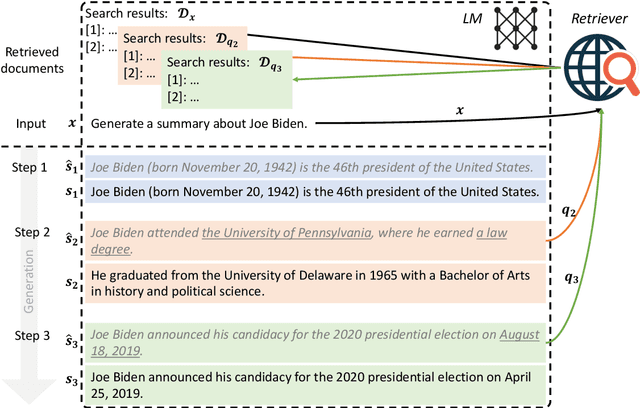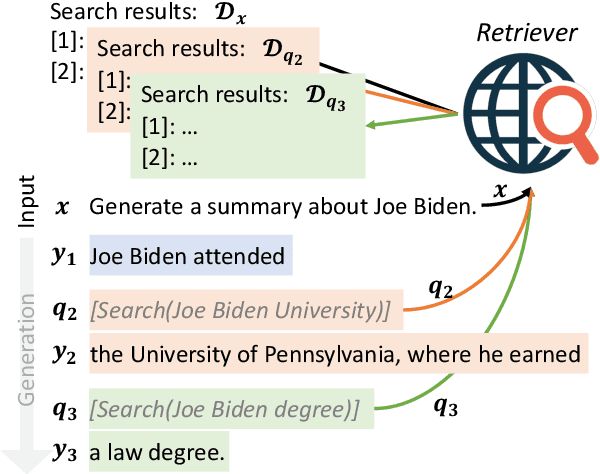Jamie Callan
Repository-level Code Search with Neural Retrieval Methods
Feb 10, 2025Abstract:This paper presents a multi-stage reranking system for repository-level code search, which leverages the vastly available commit histories of large open-source repositories to aid in bug fixing. We define the task of repository-level code search as retrieving the set of files from the current state of a code repository that are most relevant to addressing a user's question or bug. The proposed approach combines BM25-based retrieval over commit messages with neural reranking using CodeBERT to identify the most pertinent files. By learning patterns from diverse repositories and their commit histories, the system can surface relevant files for the task at hand. The system leverages both commit messages and source code for relevance matching, and is evaluated in both normal and oracle settings. Experiments on a new dataset created from 7 popular open-source repositories demonstrate substantial improvements of up to 80% in MAP, MRR and P@1 over the BM25 baseline, across a diverse set of queries, demonstrating the effectiveness this approach. We hope this work aids LLM agents as a tool for better code search and understanding. Our code and results obtained are publicly available.
ACER: Automatic Language Model Context Extension via Retrieval
Oct 11, 2024Abstract:Long-context modeling is one of the critical capabilities of language AI for digesting and reasoning over complex information pieces. In practice, long-context capabilities are typically built into a pre-trained language model~(LM) through a carefully designed context extension stage, with the goal of producing generalist long-context capabilities. In our preliminary experiments, however, we discovered that the current open-weight generalist long-context models are still lacking in practical long-context processing tasks. While this means perfectly effective long-context modeling demands task-specific data, the cost can be prohibitive. In this paper, we draw inspiration from how humans process a large body of information: a lossy \textbf{retrieval} stage ranks a large set of documents while the reader ends up reading deeply only the top candidates. We build an \textbf{automatic} data synthesis pipeline that mimics this process using short-context LMs. The short-context LMs are further tuned using these self-generated data to obtain task-specific long-context capabilities. Similar to how pre-training learns from imperfect data, we hypothesize and further demonstrate that the short-context model can bootstrap over the synthetic data, outperforming not only long-context generalist models but also the retrieval and read pipeline used to synthesize the training data in real-world tasks such as long-context retrieval augmented generation.
SciCode: A Research Coding Benchmark Curated by Scientists
Jul 18, 2024



Abstract:Since language models (LMs) now outperform average humans on many challenging tasks, it has become increasingly difficult to develop challenging, high-quality, and realistic evaluations. We address this issue by examining LMs' capabilities to generate code for solving real scientific research problems. Incorporating input from scientists and AI researchers in 16 diverse natural science sub-fields, including mathematics, physics, chemistry, biology, and materials science, we created a scientist-curated coding benchmark, SciCode. The problems in SciCode naturally factorize into multiple subproblems, each involving knowledge recall, reasoning, and code synthesis. In total, SciCode contains 338 subproblems decomposed from 80 challenging main problems. It offers optional descriptions specifying useful scientific background information and scientist-annotated gold-standard solutions and test cases for evaluation. Claude3.5-Sonnet, the best-performing model among those tested, can solve only 4.6% of the problems in the most realistic setting. We believe that SciCode demonstrates both contemporary LMs' progress towards becoming helpful scientific assistants and sheds light on the development and evaluation of scientific AI in the future.
Dwell in the Beginning: How Language Models Embed Long Documents for Dense Retrieval
Apr 05, 2024Abstract:This study investigates the existence of positional biases in Transformer-based models for text representation learning, particularly in the context of web document retrieval. We build on previous research that demonstrated loss of information in the middle of input sequences for causal language models, extending it to the domain of representation learning. We examine positional biases at various stages of training for an encoder-decoder model, including language model pre-training, contrastive pre-training, and contrastive fine-tuning. Experiments with the MS-MARCO document collection reveal that after contrastive pre-training the model already generates embeddings that better capture early contents of the input, with fine-tuning further aggravating this effect.
Building Retrieval Systems for the ClueWeb22-B Corpus
Feb 06, 2024Abstract:The ClueWeb22 dataset containing nearly 10 billion documents was released in 2022 to support academic and industry research. The goal of this project was to build retrieval baselines for the English section of the "super head" part (category B) of this dataset. These baselines can then be used by the research community to compare their systems and also to generate data to train/evaluate new retrieval and ranking algorithms. The report covers sparse and dense first stage retrievals as well as neural rerankers that were implemented for this dataset. These systems are available as a service on a Carnegie Mellon University cluster.
Active Retrieval Augmented Generation
May 11, 2023



Abstract:Despite the remarkable ability of large language models (LMs) to comprehend and generate language, they have a tendency to hallucinate and create factually inaccurate output. Augmenting LMs by retrieving information from external knowledge resources is one promising solution. Most existing retrieval-augmented LMs employ a retrieve-and-generate setup that only retrieves information once based on the input. This is limiting, however, in more general scenarios involving generation of long texts, where continually gathering information throughout the generation process is essential. There have been some past efforts to retrieve information multiple times while generating outputs, which mostly retrieve documents at fixed intervals using the previous context as queries. In this work, we provide a generalized view of active retrieval augmented generation, methods that actively decide when and what to retrieve across the course of the generation. We propose Forward-Looking Active REtrieval augmented generation (FLARE), a generic retrieval-augmented generation method which iteratively uses a prediction of the upcoming sentence to anticipate future content, which is then utilized as a query to retrieve relevant documents to regenerate the sentence if it contains low-confidence tokens. We test FLARE along with baselines comprehensively over 4 long-form knowledge-intensive generation tasks/datasets. FLARE achieves superior or competitive performance on all tasks, demonstrating the effectiveness of our method. Code and datasets are available at https://github.com/jzbjyb/FLARE.
Precise Zero-Shot Dense Retrieval without Relevance Labels
Dec 20, 2022Abstract:While dense retrieval has been shown effective and efficient across tasks and languages, it remains difficult to create effective fully zero-shot dense retrieval systems when no relevance label is available. In this paper, we recognize the difficulty of zero-shot learning and encoding relevance. Instead, we propose to pivot through Hypothetical Document Embeddings~(HyDE). Given a query, HyDE first zero-shot instructs an instruction-following language model (e.g. InstructGPT) to generate a hypothetical document. The document captures relevance patterns but is unreal and may contain false details. Then, an unsupervised contrastively learned encoder~(e.g. Contriever) encodes the document into an embedding vector. This vector identifies a neighborhood in the corpus embedding space, where similar real documents are retrieved based on vector similarity. This second step ground the generated document to the actual corpus, with the encoder's dense bottleneck filtering out the incorrect details. Our experiments show that HyDE significantly outperforms the state-of-the-art unsupervised dense retriever Contriever and shows strong performance comparable to fine-tuned retrievers, across various tasks (e.g. web search, QA, fact verification) and languages~(e.g. sw, ko, ja).
Retrieval as Attention: End-to-end Learning of Retrieval and Reading within a Single Transformer
Dec 05, 2022



Abstract:Systems for knowledge-intensive tasks such as open-domain question answering (QA) usually consist of two stages: efficient retrieval of relevant documents from a large corpus and detailed reading of the selected documents to generate answers. Retrievers and readers are usually modeled separately, which necessitates a cumbersome implementation and is hard to train and adapt in an end-to-end fashion. In this paper, we revisit this design and eschew the separate architecture and training in favor of a single Transformer that performs Retrieval as Attention (ReAtt), and end-to-end training solely based on supervision from the end QA task. We demonstrate for the first time that a single model trained end-to-end can achieve both competitive retrieval and QA performance, matching or slightly outperforming state-of-the-art separately trained retrievers and readers. Moreover, end-to-end adaptation significantly boosts its performance on out-of-domain datasets in both supervised and unsupervised settings, making our model a simple and adaptable solution for knowledge-intensive tasks. Code and models are available at https://github.com/jzbjyb/ReAtt.
ClueWeb22: 10 Billion Web Documents with Visual and Semantic Information
Dec 02, 2022Abstract:ClueWeb22, the newest iteration of the ClueWeb line of datasets, provides 10 billion web pages affiliated with rich information. Its design was influenced by the need for a high quality, large scale web corpus to support a range of academic and industry research, for example, in information systems, retrieval-augmented AI systems, and model pretraining. Compared with earlier ClueWeb corpora, the ClueWeb22 corpus is larger, more varied, of higher-quality, and aligned with the document distributions in commercial web search. Besides raw HTML, ClueWeb22 includes rich information about the web pages provided by industry-standard document understanding systems, including the visual representation of pages rendered by a web browser, parsed HTML structure information from a neural network parser, and pre-processed cleaned document text to lower the barrier to entry. Many of these signals have been widely used in industry but are available to the research community for the first time at this scale.
PAL: Program-aided Language Models
Nov 18, 2022



Abstract:Large language models (LLMs) have recently demonstrated an impressive ability to perform arithmetic and symbolic reasoning tasks when provided with a few examples at test time (few-shot prompting). Much of this success can be attributed to prompting methods for reasoning, such as chain-of-thought, that employ LLMs for both understanding the problem description by decomposing it into steps, as well as solving each step of the problem. While LLMs seem to be adept at this sort of step-by-step decomposition, LLMs often make logical and arithmetic mistakes in the solution part, even when the problem is correctly decomposed. We present Program-Aided Language models (PaL): a new method that uses the LLM to understand natural language problems and generate programs as the intermediate reasoning steps, but offloads the solution step to a programmatic runtime such as a Python interpreter. With PaL, decomposing the natural language problem into runnable steps remains the only learning task for the LLM, while solving is delegated to the interpreter. We experiment with 12 reasoning tasks from BIG-Bench Hard and other benchmarks, including mathematical reasoning, symbolic reasoning, and algorithmic problems. In all these natural language reasoning tasks, generating code using an LLM and reasoning using a Python interpreter leads to more accurate results than much larger models, and we set new state-of-the-art results in all 12 benchmarks. For example, PaL using Codex achieves state-of-the-art few-shot accuracy on the GSM benchmark of math word problems when the model is allowed only a single decoding, surpassing PaLM-540B with chain-of-thought prompting by an absolute 8% .In three reasoning tasks from the BIG-Bench Hard benchmark, PaL outperforms CoT by 11%. On GSM-hard, a more challenging version of GSM that we create, PaL outperforms chain-of-thought by an absolute 40%.
 Add to Chrome
Add to Chrome Add to Firefox
Add to Firefox Add to Edge
Add to Edge